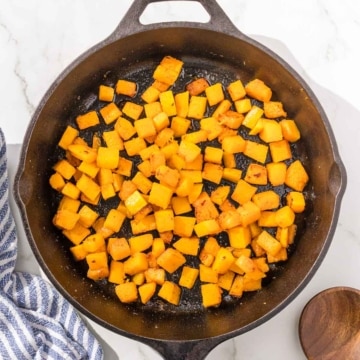
Sautéed Butternut Squash
Ready in 20 minutes, this creamy, sweet, tender sautéed butternut squash is an easy, quick, and versatile addition to any meal!
Print
Pin
Servings: 4 ½-cup servings
Calories: 95kcal
Equipment
Ingredients
- 2 tablespoons olive oil
- 2 cups butternut squash heaping, from 1 small to medium butternut squash, peeled, cubed, and diced
- ½ teaspoon garlic powder or to taste
- ¼ teaspoon cayenne or to taste, optional
- kosher salt to taste
Instructions
- Place a pan on medium heat and add the olive oil.
- Once the oil is just shimmering, add the butternut squash.
- Let cook on one side for a few minutes until some light browning develops. Stir every minute or so for the remaining cook time.
- At the 10-minute mark, season with salt, garlic powder, and cayenne.
- At the 15-minute mark, check to see if the squash is tender throughout and has achieved light golden brown coloring in places. If so, your squash is ready to serve. If not, continue cooking for a few more minutes until done.
Notes
- Step-by-step instructions for cutting butternut squash can be found in the body of this post.
- Store in an airtight container in the fridge for 4 to 5 days. Reheat on the stovetop over medium heat with a bit of oil, or in the microwave if you're short on time.
- Sautéed butternut squash can be frozen on a sheet tray, ensuring the pieces are separated, then transferred to a freezer-safe container and stored for about 3 months. To reheat, thaw overnight, then heat in a pan on the stove over medium heat with a bit of oil.
- For a larger serving, purchase a larger squash (or two) and work in batches.
- For even cooking, cut your butternut squash into very similarly shaped cubes. This will provide even heat distribution and allow each cube to cook at the same rate.
- When selecting butternut squash, choose one with an even beige exterior. Scarring on the surface is normal, but avoid soft spots or cuts that puncture the skin. Choose one that is heavy for its size with no bruises and an intact stem.
- Choose a sharp knife and a sturdy cutting board on a flat surface when cutting your butternut squash. They can take a little bit of muscle to get through, so avoid injury by using the best possible tools.
Nutrition
Calories: 95kcal | Carbohydrates: 9g | Protein: 1g | Fat: 7g | Saturated Fat: 1g | Polyunsaturated Fat: 1g | Monounsaturated Fat: 5g | Sodium: 3mg | Potassium: 253mg | Fiber: 1g | Sugar: 2g | Vitamin A: 7493IU | Vitamin C: 15mg | Calcium: 34mg | Iron: 1mg